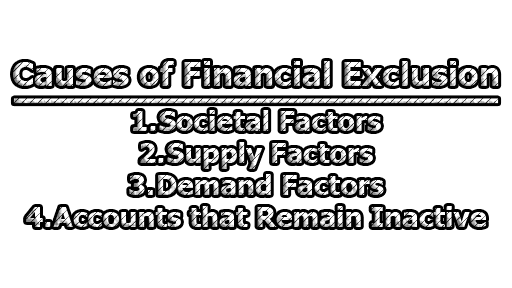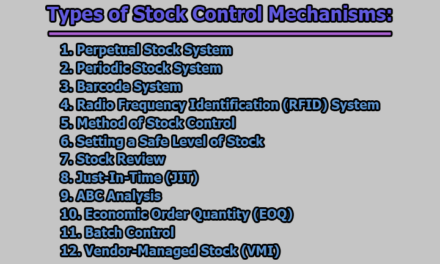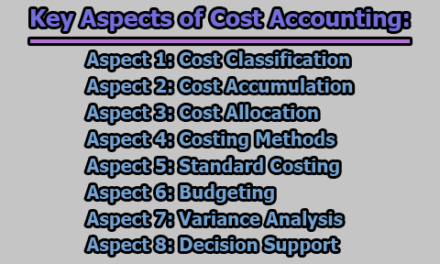Financial exclusion refers to a situation where individuals or groups are unable to access or use financial services that are necessary for their daily lives or long-term financial planning. This may be due to a variety of factors, such as poverty, lack of financial literacy, geographic barriers, discrimination, or a lack of access to banking services. Financial exclusion can have severe consequences for individuals and communities, including limited access to credit, inability to save money or make investments, and limited ability to participate in the formal economy. It can also exacerbate social and economic inequalities and perpetuate poverty. Efforts to address financial exclusion may involve increasing access to financial services, improving financial literacy, and promoting policies and initiatives that support financial inclusion for all members of society. In the rest of this article, we are going to know about the causes of financial exclusion and financial exclusion in developed economies.
Definitions of Financial Exclusion:
Financial exclusion is the inability of individuals or households to access and use appropriate financial services that meet their needs and are affordable, convenient, and sustainable. This definition was given by the World Bank in its report titled “Measuring Financial Inclusion: The Global Findex Database 2014.”
According to the European Commission, financial exclusion refers to the situation where individuals and groups are unable to access basic financial services, such as bank accounts, credit, insurance, and payment services, that are necessary to participate fully in society and the economy.
The Financial Conduct Authority (FCA) in the UK defines financial exclusion as “the inability of certain groups of consumers to access mainstream financial services in ways that meet their needs and at a cost they can afford.” This definition emphasizes the importance of affordability and accessibility in financial services.
The Consultative Group to Assist the Poor (CGAP) defines financial exclusion as “the absence or limited access to formal financial services that meet the needs of low-income households and micro-entrepreneurs.” This definition highlights the impact of financial exclusion on the most vulnerable members of society.
The United Nations Development Programme (UNDP) defines financial exclusion as “the absence of access to formal financial services, and the inability of certain individuals and households to participate in the financial system.” This definition emphasizes the importance of financial inclusion as a means of reducing poverty and promoting economic development.
Causes of Financial Exclusion:
Financial exclusion is a complex issue that affects individuals and households worldwide. It is caused by a combination of societal, supply, and demand factors, as well as by accounts that remain inactive. These causes of financial exclusion are briefly given below:
- Societal Factors: Financial exclusion can be caused by societal factors such as income inequality, poverty, lack of education, and discrimination. In societies where income inequality is high, those at the bottom of the income distribution may find it difficult to access financial services due to a lack of income, assets, and collateral. Similarly, poverty can limit access to financial services, as people may not have enough disposable income to save or invest. Lack of education can also be a factor, as people may not have the necessary financial literacy skills to understand how financial products work. Discrimination can also play a role, as marginalized groups such as women, minorities, and people with disabilities may face barriers to accessing financial services.
- Supply Factors: Supply factors refer to the availability and accessibility of financial services. Financial exclusion can be caused by a lack of physical infrastructure, such as bank branches or ATMs, in rural or remote areas. Additionally, financial institutions may not offer products that meet the needs of low-income individuals or those with irregular income streams. The cost of financial services can also be a barrier, as people may not be able to afford high fees or minimum account balances. Finally, regulations and bureaucratic processes can create barriers to accessing financial services, particularly for those with limited documentation or proof of identity.
- Demand Factors: Demand factors refer to the willingness and ability of individuals to use financial services. Financial exclusion can be caused by a lack of awareness or trust in financial products, as well as by cultural or social norms that discourage the use of formal financial services. In some cases, individuals may prefer to use informal financial services, such as money lenders or savings clubs, rather than formal financial institutions. Language barriers and limited access to technology can also limit the use of financial services.
- Accounts that Remain Inactive: In some cases, financial exclusion can be caused by accounts that remain inactive. This can occur when people open accounts but do not use them, either because they do not understand how to use them or because they do not see the benefits of doing so. In some cases, financial institutions may also close inactive accounts, which can further limit access to financial services.
Financial Exclusion in Developed Economies:
Financial exclusion is not limited to developing economies, but it is also a persistent problem in developed economies. Here, we are going to discuss financial exclusion in developed economies, including its causes and effects, as well as some of the solutions that have been proposed to address it.
A. Causes of Financial Exclusion in Developed Economies:
- Income Inequality: Income inequality is a significant factor in financial exclusion in developed economies. A large income gap between the rich and the poor can limit access to financial services for low-income individuals, who may not have sufficient income, assets, or collateral to qualify for loans or credit.
- High Fees and Charges: In developed economies, financial institutions may impose high fees and charges for financial services, which can be a significant barrier to access. People with low income may not be able to afford high fees or minimum account balances, and this can lead to their exclusion from the financial system.
- Digital Divide: The increasing use of digital technology in financial services can lead to the exclusion of people who are not comfortable using digital technology or do not have access to it. The digital divide between those who have access to the internet and those who do not can result in financial exclusion.
- Lack of Financial Literacy: Low levels of financial literacy can limit people’s ability to access financial services. Many people in developed economies do not have the knowledge or skills to use financial products effectively, which can limit their access to credit and other financial services.
B. Effects of Financial Exclusion in Developed Economies:
- Higher Borrowing Costs: People who are excluded from the formal financial system may turn to high-cost lenders, such as payday lenders, which can result in higher borrowing costs and financial difficulties.
- Limited Access to Credit: Without access to credit, people may not be able to invest in education, start businesses, or buy homes. This can limit their ability to achieve financial stability and progress.
- Increased Risk of Poverty: Financial exclusion can lead to an increased risk of poverty, particularly for low-income individuals and families.
- Social and Economic Exclusion: Financial exclusion can result in social and economic exclusion, as people who are excluded from the financial system may not be able to participate fully in the economy or society.
C. Solutions to Address Financial Exclusion in Developed Economies:
- Financial Education: Governments, financial institutions, and nonprofit organizations can increase financial literacy through education programs to help people understand how to use financial products and services effectively.
- Innovative Financial Products: Financial institutions can develop innovative financial products that are accessible and affordable to low-income individuals and families, such as microfinance and microcredit.
- Regulatory Frameworks: Governments can establish regulatory frameworks that ensure that financial institutions provide affordable and accessible financial services to low-income individuals and families.
- Digital Inclusion: Efforts should be made to close the digital divide and ensure that everyone has access to digital technology, which can improve financial inclusion.
Financial exclusion is a persistent problem in developed economies, and its causes and effects are complex. Addressing financial exclusion in developed economies requires a multifaceted approach that involves financial education, innovative financial products, regulatory frameworks, and digital inclusion. By addressing financial exclusion, developed economies can create more inclusive and equitable financial systems that benefit everyone.
References:
- Kim, J., Lee, J., & Lee, Y. (2020). Causes and Effects of Financial Exclusion in Developed Economies. Sustainability, 12(4), 1332. https://doi.org/10.3390/su12041332
- House of Commons Library. (2020). Financial inclusion: policy and progress. https://commonslibrary.parliament.uk/research-briefings/cbp-7298/
- Tadesse, S., & Greenberg, R. (2021). Financial Inclusion and the Digital Divide. International Journal of Finance and Economics, 26(1), 1-15. https://doi.org/10.1002/ijfe.1762
- Harvey, J., & Gow, H. (2019). Financial exclusion in developed economies: A comparative analysis of the UK and Australia. Journal of European Social Policy, 29(5), 584-598. https://doi.org/10.1177/0958928719865171
- (2018). Financial Inclusion: Why it matters and how to achieve it. https://www.pwc.com/gx/en/banking-capital-markets/publications/financial-inclusion-why-it-matters-and-how-to-achieve-it.html

Library Lecturer at Nurul Amin Degree College










